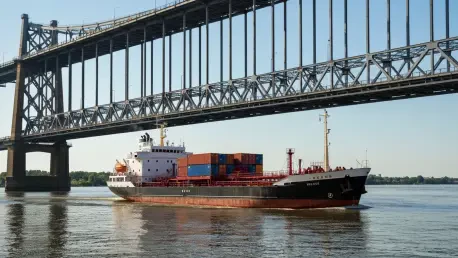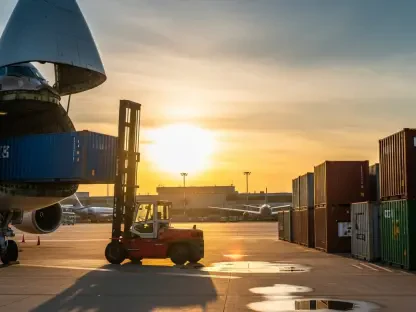In the early hours of a chilling March night, a massive cargo ship named Dali, measuring as long as the Eiffel Tower is tall, lost control in Baltimore Harbor and struck the Francis Scott Key Bridge, sending the aging structure crumbling into the icy waters below. The impact claimed six lives and halted a vital artery of American commerce, unfolding under the cover of darkness, stunning a nation, and raising a haunting question: how could a single vessel bring down an iconic bridge? This disaster serves as a stark reminder of the unseen dangers lurking at the intersection of maritime travel and infrastructure, pulling back the curtain on a series of failures waiting to be exposed.
A Devastating Night in Baltimore Harbor
The clock had just passed midnight on March 26, 2024, when the Dali, a colossal container ship, veered off course in the still waters of Baltimore’s Patapsco River. With no power to steer or propel itself, the vessel became an unstoppable force, ramming into a critical support pillar of the Francis Scott Key Bridge. Within moments, the bridge—a lifeline for thousands of daily commuters and a key link for East Coast trade—collapsed in a cacophony of twisting steel and shattered concrete, trapping workers who had no time to escape.
The human toll was immediate and heartbreaking. Six construction workers, laboring on overnight repairs, perished in the collapse, their families left to grapple with an unimaginable loss. Beyond the personal tragedy, the port of Baltimore, one of the busiest in the nation, ground to a halt, disrupting supply chains and costing millions in economic damage each day. This wasn’t merely an accident; it was a catastrophic failure that reverberated far beyond Maryland’s shores.
The significance of this event lies in its broader implications for safety and infrastructure across the United States. With thousands of vessels navigating busy waterways and countless bridges standing as aging sentinels, the incident exposes a fragility in systems many take for granted. The National Transportation Safety Board (NTSB) stepped in to unravel the disaster, revealing a web of technical, human, and systemic breakdowns that demand urgent attention.
The Personal and National Impact
For communities near Baltimore, the collapse shattered a sense of security. Residents who crossed the bridge daily now face detours and uncertainty, while port workers and businesses dependent on maritime trade endure financial strain. The incident’s ripple effects touch millions, as delayed shipments of goods like automobiles and coal disrupt markets nationwide, highlighting how a single point of failure can cripple an interconnected economy.
On a national scale, the disaster underscores a chilling reality: dozens of other bridges across the country share similar vulnerabilities. According to the NTSB, many structures built decades ago were not designed to withstand collisions from today’s gargantuan ships, which have grown significantly since the widening of the Panama Canal in 2016. This mismatch between modern maritime traffic and outdated infrastructure poses a silent threat to public safety, making the Baltimore tragedy a warning for every city with a waterway.
Public trust in transportation systems has also taken a hit. When a bridge as prominent as the Francis Scott Key can fall, questions arise about the reliability of oversight and the prioritization of safety over cost. The emotional weight of losing six lives amplifies these concerns, pushing regulators, engineers, and citizens to demand answers and accountability from those responsible for preventing such catastrophes.
Piecing Together a Cascade of Failures
The NTSB’s exhaustive investigation, culminating in a board meeting on November 18, 2024, paints a grim picture of compounded errors behind the Dali’s deadly collision. At the root was a seemingly minor flaw—a loose wiring connection from the ship’s construction in 2015—that triggered a circuit breaker to trip, plunging the vessel into a complete power blackout. Without propulsion or steering, the Dali became a 95,000-ton battering ram, helpless against the current dragging it toward the bridge.
Human error further deepened the crisis. As the crew scrambled to restore power after the initial blackout, they relied on an incorrect fuel pump configuration, likely a workaround for handling low-sulfur fuels required by emissions regulations. This misstep, undetected by the ship’s operator, Synergy, prevented an automatic restart and led to a second blackout at the worst possible moment. The NTSB report notes that such operational lapses reflect gaps in training and oversight, turning a recoverable glitch into an inevitable disaster.
Systemic issues also played a critical role. The Francis Scott Key Bridge, constructed in 1977, adhered to design standards obsolete for today’s maritime giants. Lacking protective barriers around its supports, the structure stood defenseless against the Dali’s sheer mass. Combined with managerial shortcomings at Synergy and inconsistencies in safety certifications by Class Societies, the investigation reveals a perfect storm of technical, operational, and regulatory failures that no single entity could contain.
Voices from the Investigation
NTSB Chair Jennifer Homendy delivered a sobering assessment, emphasizing the “unintended consequences” of emissions standards that may have influenced the crew’s fuel pump error. Her vivid comparison of the Dali’s length to iconic landmarks drove home the scale of modern ships and the inadequacy of aging bridges to withstand them. “We’re dealing with vessels that dwarf the infrastructure they pass under,” Homendy stated, urging a reevaluation of safety protocols in an era of ever-larger maritime traffic.
Experts on the panel, drawing from diverse fields like marine safety and aviation, highlighted additional blind spots. One critical flaw was the ship’s Vessel Data Recorder, which failed to capture vital communications during the crisis—a recurring issue seen in past maritime disasters like the 2015 El Faro sinking. This gap in technology, contrasted with aviation’s robust black boxes, limits investigators’ ability to fully reconstruct events and learn from them, prompting calls for upgraded recording standards.
The NTSB’s collective voice stressed urgency. With similar risks identified at bridges nationwide, panel members advocated for immediate assessments and retrofitting projects. Their cross-disciplinary insights, blending perspectives from different transport sectors, underscored a shared belief that systemic reform is not optional but essential to prevent history from repeating itself in another harbor.
Building a Safer Tomorrow
In response to the tragedy, the NTSB laid out a comprehensive blueprint to avert future disasters. For ship operators like Synergy, adopting cutting-edge tools such as infrared thermal imaging to detect hidden electrical faults stands as a priority. Crew training must also adapt, ensuring proper handling of fuel systems under emissions mandates to eliminate operational errors that can spiral out of control in critical moments.
Regulatory bodies, including the U.S. Coast Guard and the International Maritime Organization, face pressure to revisit fuel standards and safety protocols. The goal is to strike a balance between environmental objectives and operational reliability, addressing the unintended risks flagged by investigators. Strengthening oversight of vessel maintenance and certification processes will further close loopholes that allowed the Dali’s defects to go unnoticed for nearly a decade.
On the infrastructure front, modernizing bridge designs and installing protective barriers around vulnerable supports are non-negotiable steps. The NTSB also suggests deploying escort tugs in high-risk ports to guide large vessels safely, though practices vary by location. Starting from 2025, a nationwide push to assess and upgrade at-risk bridges could span several years, requiring coordinated effort between federal, state, and local authorities to safeguard communities and commerce alike.
Reflecting on a Preventable Loss
Looking back, the collapse of the Francis Scott Key Bridge stood as a tragic lesson in the fragility of systems long taken for granted. The loss of six lives and the economic fallout that followed exposed a chain of preventable failures, from a single loose wire to outdated infrastructure unable to withstand modern challenges. Each misstep, documented with painstaking detail by investigators, revealed how interconnected risks could culminate in devastation.
Moving forward, the path to safety demands bold action. Implementing advanced inspection technologies, updating training for maritime crews, and retrofitting vulnerable bridges offer tangible ways to honor those lost by ensuring no other community endures such a catastrophe. Beyond immediate fixes, a cultural shift toward proactive risk management in both shipping and infrastructure sectors emerges as the lasting legacy of this disaster, urging all stakeholders to prioritize resilience over complacency.









